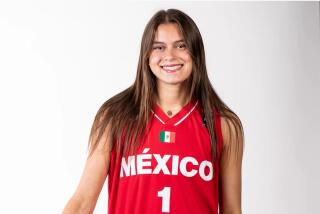They watch birdies across border now
MEXICO CITY — Karla Diaz first picked up a golf club when she was 13 and has spent much of her time since then dreaming of a spot on the LPGA Tour.
But no matter how much she plays or how hard she tries, the Mexico City teenager is resigned to the fact that she can’t get there from here.
“If you’re thinking about the big leagues, you have to look toward the United States,” Diaz says after her regular Saturday morning practice session at the Club Campestre, Mexico’s oldest golf course.
“That’s the trampoline to the professional ranks, where you can improve your technique and, above all, participate in international tournaments and play against other people at higher levels.”
She’s not the only one who feels that way. With college golf nonexistent and even club competition limited by the fact there are just more than 200 golf courses in a country of 110 million people, Mexico’s best female players are now scrambling across the border to U.S. schools, a route many see as the only path to the pros.
When LPGA Futures Tour veteran Marcela Leon of Monterrey accepted an invitation to San Jose State a decade ago, she said she was one of only three Mexican women playing college golf in the U.S. This spring, there were six times as many, playing at such schools as Arizona and Arizona State, Boise State, Michigan State, Kentucky’s Murray State and schools all over North Carolina.
“They know that the opportunity is here. That really the best players are coming to the United States to play collegiate golf, to get the experience of just playing with the best players from all over the world,” says Andrea Gaston, coach of defending NCAA champion USC.
In that way college golf simply mirrors the LPGA Tour, which comes to Rancho Mirage for this week’s Kraft Nabisco Championship with a tour roster that features 122 international players, including 47 from South Korea, 14 from Sweden and 10 from Australia.
But defending champion Lorena Ochoa, a three-time LPGA player of the year who starred at Arizona, is one of only two Mexicans on the tour. Given her country’s growing impact on the college level, however, that’s a number many expect will grow shortly.
“We’re all following her,” says Guadalajara’s Sophia Sheridan, who won an NCAA regional championship while at California and is the only Mexican besides Ochoa with an LPGA Tour card. “If she hadn’t opened the door for me at least -- she was the one that recommended my name and she was the one that convinced me to go -- I wouldn’t have gone.”
Arizona State sophomore Liisa Kelo from Mexico City agrees.
“Lorena is an inspiration to all of us. She’s a great player to follow,” Kelo says. “Mexican players coming to the United States, it was happening before Lorena’s time. But not as much, not in that big a quantity. Lorena’s success has skyrocketed that.”
So much so that when Arizona teammates Alejandra Llaneza and Margarita Ramos, both of Mexico City, competed in the Mexican women’s amateur earlier this year, Ramos said, “It pretty much looked like a college tournament.”
But it took more than the success of a single golfer -- even one as dominant as Ochoa -- to make that happen. Other contributing factors, say college coaches and players, include Mexico’s proximity to the U.S., the complicated college education system in Mexico, the decline of women’s junior golf in the U.S. and NCAA regulations that allow women’s teams to award six full scholarships, 1 1/2 more than men’s programs are allowed.
“Golf is an international sport. And our jobs as coaches are to find the best junior golfers in the world, not just the best junior golfers in the States,” says Arizona Coach Shelly Haywood, who moved last February’s Wildcat Invitational from Tucson to Sonora, Mexico, where her players staged clinics for local golfers. (The LPGA is also helping sell the game in Mexico, having staged three tour events there in 2008.)
“I get a lot of calls and e-mails and letters from Mexican players,” Haywood says. “Every week, practically.”
But even though a fifth of her roster, not to mention her school’s most famous alumna, came from Mexico, Haywood insists the players get far more from the relationship than the university does.
“Obviously, we get the exposure with the kids from Mexico. But it’s more about them. It’s what they’re receiving from us,” she says. “They get a great education. They get an opportunity to play college golf at the highest level.”
Which is why, even in smoggy, overcrowded Mexico City, all golf-cart paths continue to head north.
“If you want to be a professional in the class of Lorena Ochoa or Tiger [Woods], you have to go to the United States,” 14-year-old Claudia Esparza, who travels an hour and a half each way from her home to Club Campestre, says with resignation. “As far I know, that kind of help doesn’t exist here.”
--
cecilia.sanchez@latimes.com
More to Read
Go beyond the scoreboard
Get the latest on L.A.'s teams in the daily Sports Report newsletter.
You may occasionally receive promotional content from the Los Angeles Times.











